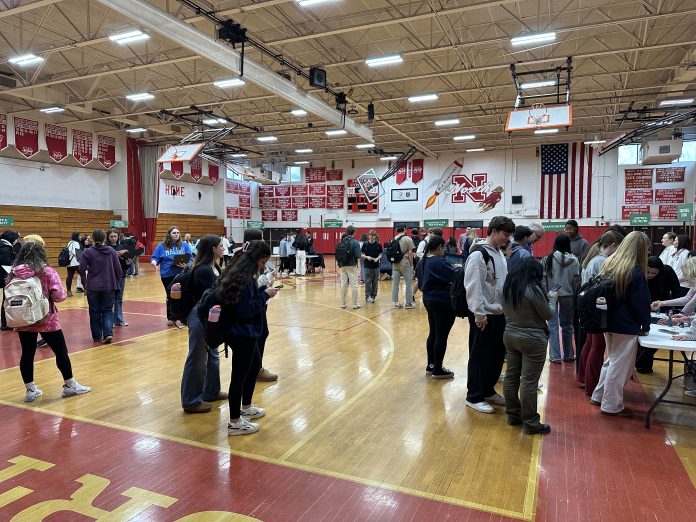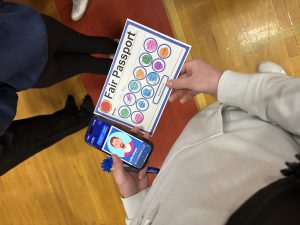

By Geena Monahan—For the North Star Reporter
A financial literacy program called Credit for Life offered North Attleborough High School juniors with real-life budgeting and money management skills.
Thursday morning, teens filtered in throughout the three hour-long fair, visiting different booths with their Chromebooks in hand after setting up a profile on the Credit for Life app, where they chose a career and were given a “salary” to make financial decisions with and mirror what their lives could look like in the future.
Lisa Magit, career specialist at NAHS, explained that in conjunction with the Attleboro-area School-to-Career Partnership, a nonprofit that prepares students for the future by coordinating work-based learning activities, a hybrid version of the program was brought in about five years ago.
“It’s an opportunity for kids to understand what the real world is going to be like,” said Magit. “Similar to the game of Life, they have a salary and have to plan for the future and pay off some student loans, find a place to live and figure out transportation. They start to understand, ‘this is what I earn, these are all the expenses I have, so how am I going to manage, or mismanage, my money?’”
Students traveled from booth to booth, getting their “passports” stamped on their journey to balancing a budget. The “transportation” booth was a stop where they had the options of buying a new car, something used and less expensive but potentially less reliable, or take public transit if moving to a city.
Students visited the “life skills booth,” where they learned how to write a check and tie a tie, and also went to the “lifestyle” table where decided if they had $75 a month in their budget to keep getting their nails done, and if they will make enough to money to pay their cell phone bills or go on a vacation.
The Hockomock Area YMCA was also at the fair, hosting a “charitable giving” booth where students were given the option to give monetary donations to nonprofits or donate their time, with most choosing a combination of both.
The final step was to complete the “budget review” portion, where students looked at all of the financial decisions they chose along the way and made adjustments to their budgets based on how their imaginary accounts looked and how much credit card debit they accrued during the simulation.
One of those students was Sharanya Valluri, who chose to be an engineer for her career mock-up, hoping to get a realistic view of her future, as she plans to study engineering in college. When asked what adulthood costs most surprised her, Valluri mentioned housing and saving for retirement. Valluri said at the “planning for the future” table she initially chose the option to put aside 10% of her earnings towards retirement, but had to bump that number down to 5% after realizing how much money it would take out of her paycheck.
“I personally thought it was really helpful,” said Valluri. “It helped me understand the reality that it’s not long until I have to start worrying about this. I feel like getting a head start lets me prepare myself and gives me motivation.”
Valluri also learned that in order to achieve a career in engineering, she would need a master’s degree. When she ran simulations on the app about the costs of private and public education, Valluri came to the realization that she would need to attend a public college in order to afford both degrees, choosing an in-state college instead to save money.
NAHS is one of just 16 Massachusetts school districts that require students to take a personal finance class in order to graduate, and Kimberly Robbins is one of three educators who teach this course. According to Robbins, her students are always surprised to learn how expensive the cost of living is and how much money will get taken out of their gross pay. Robbins also said it forces them to think about the little things they will become responsible for when they live on their own, such as cleaning supplies, hair care and beauty items, clothes, and grocery shopping.
“We love teaching the course,” said Robbins. “We want our kids to be reading literate and digitally literate, so why wouldn’t we want our kids to be financially literate?”
North Easton Savings Bank is one of Credit for Life’s main sponsors, and Mortgage Operations Manager Kami McMorrow talked about how the program has evolved over the 22 years she has been involved in it.
“When we started it was all paper; we were hand writing and adding,” McMorrow said. “But now with the app it’s a lot easier and it’s more relatable to the kids. The kids are online banking, they’re doing virtual transfers. Nobody gets statement balance checking accounts anymore, but they do have to learn to live within a budget.”
McMorrow noted that as a banker, you see people come in everyday who have no idea what to do with their money, which served as the catalyst for local banks supporting and partnering with the Credit for Life program from the very beginning. According to McMorrow, the students they see today are going to be their future customers, borrowers and depositors.
“I work in mortgage lending, and the things I see that make it hard to qualify for first-time homeowners is student loan debt and a brand new car,” said McMorrow. “If we’re teaching them how to be savvy and smart, they’re going to know what questions to ask, they’re going to be more in the driver’s seat. If you can reach even a few of them, that makes it worth it.”
